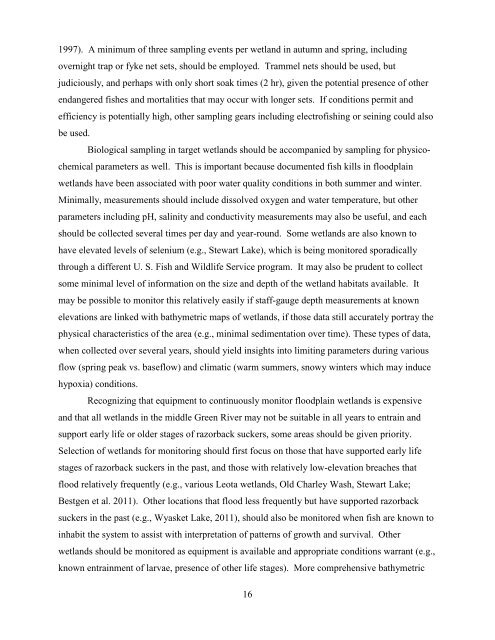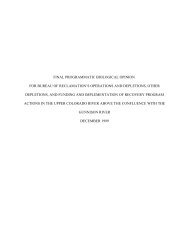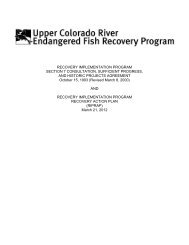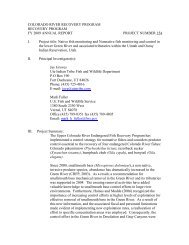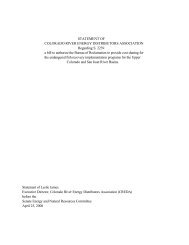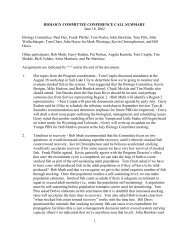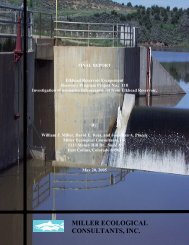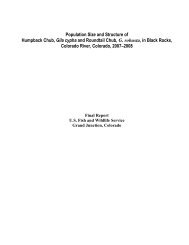K. R. Bestgen, K. A. Zelasko, and G. C. White. Monitoring ...
K. R. Bestgen, K. A. Zelasko, and G. C. White. Monitoring ...
K. R. Bestgen, K. A. Zelasko, and G. C. White. Monitoring ...
You also want an ePaper? Increase the reach of your titles
YUMPU automatically turns print PDFs into web optimized ePapers that Google loves.
1997). A minimum of three sampling events per wetl<strong>and</strong> in autumn <strong>and</strong> spring, including<br />
overnight trap or fyke net sets, should be employed. Trammel nets should be used, but<br />
judiciously, <strong>and</strong> perhaps with only short soak times (2 hr), given the potential presence of other<br />
endangered fishes <strong>and</strong> mortalities that may occur with longer sets. If conditions permit <strong>and</strong><br />
efficiency is potentially high, other sampling gears including electrofishing or seining could also<br />
be used.<br />
Biological sampling in target wetl<strong>and</strong>s should be accompanied by sampling for physicochemical<br />
parameters as well. This is important because documented fish kills in floodplain<br />
wetl<strong>and</strong>s have been associated with poor water quality conditions in both summer <strong>and</strong> winter.<br />
Minimally, measurements should include dissolved oxygen <strong>and</strong> water temperature, but other<br />
parameters including pH, salinity <strong>and</strong> conductivity measurements may also be useful, <strong>and</strong> each<br />
should be collected several times per day <strong>and</strong> year-round. Some wetl<strong>and</strong>s are also known to<br />
have elevated levels of selenium (e.g., Stewart Lake), which is being monitored sporadically<br />
through a different U. S. Fish <strong>and</strong> Wildlife Service program. It may also be prudent to collect<br />
some minimal level of information on the size <strong>and</strong> depth of the wetl<strong>and</strong> habitats available. It<br />
may be possible to monitor this relatively easily if staff-gauge depth measurements at known<br />
elevations are linked with bathymetric maps of wetl<strong>and</strong>s, if those data still accurately portray the<br />
physical characteristics of the area (e.g., minimal sedimentation over time). These types of data,<br />
when collected over several years, should yield insights into limiting parameters during various<br />
flow (spring peak vs. baseflow) <strong>and</strong> climatic (warm summers, snowy winters which may induce<br />
hypoxia) conditions.<br />
Recognizing that equipment to continuously monitor floodplain wetl<strong>and</strong>s is expensive<br />
<strong>and</strong> that all wetl<strong>and</strong>s in the middle Green River may not be suitable in all years to entrain <strong>and</strong><br />
support early life or older stages of razorback suckers, some areas should be given priority.<br />
Selection of wetl<strong>and</strong>s for monitoring should first focus on those that have supported early life<br />
stages of razorback suckers in the past, <strong>and</strong> those with relatively low-elevation breaches that<br />
flood relatively frequently (e.g., various Leota wetl<strong>and</strong>s, Old Charley Wash, Stewart Lake;<br />
<strong>Bestgen</strong> et al. 2011). Other locations that flood less frequently but have supported razorback<br />
suckers in the past (e.g., Wyasket Lake, 2011), should also be monitored when fish are known to<br />
inhabit the system to assist with interpretation of patterns of growth <strong>and</strong> survival. Other<br />
wetl<strong>and</strong>s should be monitored as equipment is available <strong>and</strong> appropriate conditions warrant (e.g.,<br />
known entrainment of larvae, presence of other life stages). More comprehensive bathymetric<br />
16


